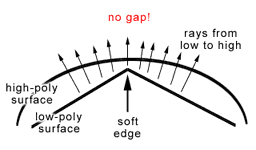

Ben has a great article there that I often refer to when pondering normal map issues.
However, I’m having trouble right now trying to explain whats happening with one of my models I am trying to bake.
One of the “Golden Rules” I have learned about normal maps over the years is that you should always make edges that define UV borders hard. This, at least as I understand it, is because there is already going to be a break in continuity between the pixels because they reside on different UV shells.
I’m having a really hard time visualizing all of this. What exactly does a UV seam do to a normal map bake and what exactly do hard edges do.
When a normal map is baked does it really project out rays perpendicular to every pixel like in the images Ben provided there, or does it work different from that. How is the tangent basis taken into account in all of this? Does it affect the angle of the rays?
Thanks in advance for any replies, this made my head spin a bit, and I would really like to be able to explain it on our internal wiki.
